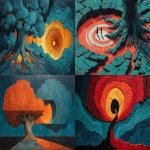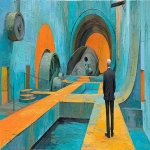Explore the Best AI Image Gallery

Beyond Reality: How VR and AR are Reshaping the Gaming Landscape
The world of gaming is undergoing a radical transformation, propelled by the immersive power of virtual reality (VR) and augmented reality (AR). These technologies are no longer confined to science fiction; they are redefining how we play, interact with games, and experience interactive entertainment.
A New Dimension of Gameplay
VR immerses players in entirely digital worlds, creating a sense of presence and agency unlike anything traditional gaming has offered. Players don headsets that transport them to fantastical landscapes, allowing them to interact with virtual environments and characters in real-time. Imagine exploring ancient ruins, battling mythical creatures, or even building your own virtual world – all from the comfort of your living room.
AR, on the other hand, overlays digital elements onto the real world, blending the physical and virtual seamlessly. Games utilizing AR can transform everyday spaces into interactive playgrounds. Think about catching Pokémon in your neighborhood, solving puzzles hidden within your home, or participating in real-world treasure hunts enhanced by digital clues.
The Creative Canvas: Unlocking Artistic Potential
VR and AR are not just about gameplay; they are powerful tools for creative expression. Developers can craft intricate worlds filled with stunning visuals, sound design that envelops the player, and narratives that unfold in entirely new ways.
Artists can utilize VR to sculpt 3D masterpieces, paint on virtual canvases, or even choreograph immersive dance performances within digital spaces. AR opens up possibilities for interactive installations, public art projects that respond to viewers movements, and games that blur the lines between reality and fantasy.
Ethical Considerations: Navigating Uncharted Territory
As with any emerging technology, VR and AR come with ethical considerations that require careful attention. Concerns about data privacy, potential addiction, the impact on social interaction, and the creation of realistic violence need to be addressed responsibly.
- Data Privacy: VR and AR often collect vast amounts of user data, including biometric information and movement patterns. Its crucial to ensure transparent data collection practices, secure storage, and user control over their personal information.
- Addiction: The immersive nature of these technologies can be highly engaging, raising concerns about potential addiction and excessive use. Developing safeguards, promoting responsible use guidelines, and encouraging balance in gaming habits are essential.
- Social Impact: Excessive VR or AR use could lead to isolation and reduced face-to-face interaction. Its important to encourage healthy social boundaries and promote activities that foster real-world connections.
The Future of Gaming: A Convergence of Reality
The future of gaming is inextricably linked to the evolution of VR and AR. We can expect increasingly realistic graphics, sophisticated artificial intelligence, and seamless integration between physical and virtual worlds.
Games could become personalized experiences tailored to individual preferences, allowing players to create their own avatars, embark on unique quests, and interact with dynamic environments that respond to their actions. The lines between reality and virtuality will continue to blur, creating exciting new possibilities for entertainment, education, and social interaction.
Conclusion
VR and AR are not just gaming trends; they represent a fundamental shift in how we experience interactive media. These technologies empower us to become creators, explorers, and storytellers within immersive digital worlds. As VR and AR continue to evolve, their impact on the creative industry and beyond will be profound, shaping the future of entertainment, art, education, and human connection.







](https://images.ai-img.art/thumbnails/150/c39d99bb3fe70fc91a3957bf15387288d25d9a69621c29d6f25846da6f7905a4.webp)










](https://images.ai-img.art/thumbnails/150/2850181349d78b8cf8e4109e1364305202a7dabe9a45aeb3b282170d13e1567f.webp)

